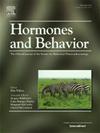青春期高脂肪饮食和社会心理应激对成年雄性Lewis大鼠神经内分泌应激反应和暴食行为的影响
IF 2.4
3区 医学
Q2 BEHAVIORAL SCIENCES
引用次数: 0
摘要
儿童肥胖是一种多因素疾病,影响全球1.6亿青少年。青少年暴露在以高脂肪饮食和压力为特征的致肥环境中,会在成年后形成不适应的饮食习惯,如暴饮暴食。有证据表明,西方高饱和脂肪(WD)食物的摄入与激素波动失调之间存在着密切的联系。然而,很少有研究探讨青少年WD和心理社会压力对大脑和行为的长期影响。这项纵向研究旨在调查青少年接触致肥性饮食对压力恢复能力的影响,并增加对暴饮暴食行为的易感性。给予青春期雄性Lewis大鼠WD(41%脂肪;n = 40)或对照饮食(CD, 16%脂肪;n = 38),然后进行捕食者暴露和社会不稳定应激方案(CDE, WDE, CDU, WDU;n = 16/组)。受试者被提供间歇性WD访问(每周24小时)以评估成年期暴饮暴食行为。在青春期和成年期的四个时间点测量粪便皮质酮和睾酮。WD大鼠青春期中期体重增加(p = 0.0217),睾酮水平升高(p = 0.0312),青春期中后期应激性皮质酮反应减弱(CDE:WDE, p = 0.028)。青春期激素水平与暴食呈负相关,这解释了成年大鼠表达贪食和贪食行为的差异。这些结果表明,在青春期接触WD会扰乱激素波动和压力反应,这种影响会持续到成年。这强调了早期解决致肥环境的重要性,以减轻其对激素调节和应激反应的持久影响。本文章由计算机程序翻译,如有差异,请以英文原文为准。
Impact of adolescent high-fat diet and psychosocial stress on neuroendocrine stress responses and binge eating behavior in adult male Lewis rats
Childhood obesity is a multifactorial disease affecting >160 million adolescents worldwide. Adolescent exposure to obesogenic environments, characterized by access to high-fat diets and stress, precipitates maladaptive eating habits in adulthood such as binge eating. Evidence suggests a strong association between Western-like high–saturated fat (WD) food consumption and dysregulated hormone fluctuations. However, few studies have explored the long-term impact of adolescent WD and psychosocial stress on brain and behavior. This longitudinal study aimed to investigate the impact of adolescent exposure to an obesogenic diet on stress resiliency and increased susceptibility for binge-like eating behaviors. Adolescent male Lewis rats were given WD (41% fat; n = 40) or control diet (CD, 16% fat; n = 38) for 4 weeks before undergoing a stress protocol of predator exposure and social instability (CDE, WDE, CDU, WDU; n = 16/group). Subjects were provided intermittent WD access (24 h/week) to evaluate binge-like eating behavior in adulthood. Fecal corticosterone and testosterone were measured at four timepoints throughout adolescence and adulthood. WD rats exhibited increased body weight (p = 0.0217) and elevated testosterone in mid-adolescence (p = 0.0312) and blunted stress-induced corticosterone response in mid-late adolescence (CDE:WDE, p = 0.028). Adolescent hormone levels were negatively correlated with binging and explained the variability between adult rats expressing hyperphagic and hypophagic behaviors. These results demonstrate that exposure to WD in adolescence disrupts hormone fluctuations and stress responsivity, with effects persisting into adulthood. This underscores the importance of addressing obesogenic environments early to mitigate their lasting impact on hormone regulation and stress responsiveness.
求助全文
通过发布文献求助,成功后即可免费获取论文全文。
去求助
来源期刊

Hormones and Behavior
医学-行为科学
CiteScore
6.70
自引率
8.60%
发文量
139
审稿时长
91 days
期刊介绍:
Hormones and Behavior publishes original research articles, reviews and special issues concerning hormone-brain-behavior relationships, broadly defined. The journal''s scope ranges from laboratory and field studies concerning neuroendocrine as well as endocrine mechanisms controlling the development or adult expression of behavior to studies concerning the environmental control and evolutionary significance of hormone-behavior relationships. The journal welcomes studies conducted on species ranging from invertebrates to mammals, including humans.
 求助内容:
求助内容: 应助结果提醒方式:
应助结果提醒方式:


